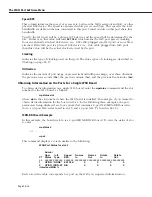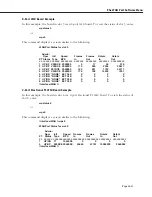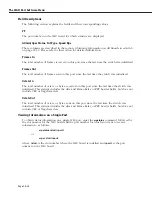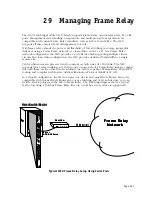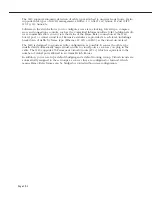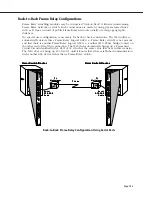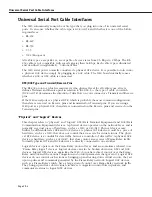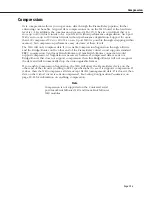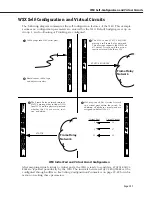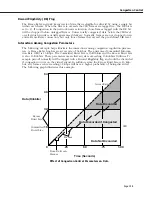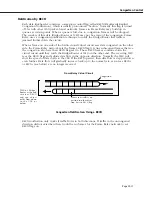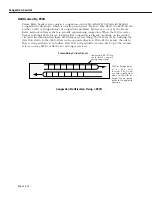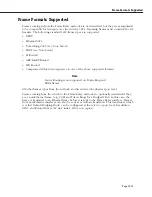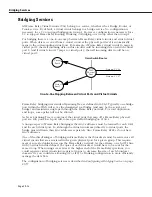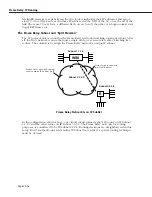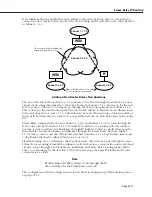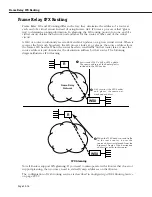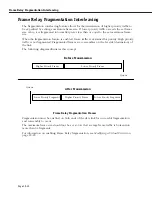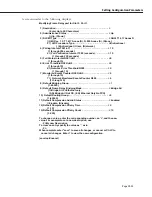
Congestion Control
Page 29-8
Congestion Control
Use of Frame Relay lines tends to be “bursty,” with heavy use at times and light use at others.
During heavy periods of congestion, data may be discarded. However, Frame Relay uses
several software-configurable parameters and techniques to control congestion and to avoid
data loss on the network during these heavy periods. These software parameters are set on a
VC-by-VC basis. This section describes these parameters.
Note
The parameters in this section describe how the Frame
Relay network handles congestion. The
WSX
supports
these parameters, but they must match those used by
your Frame Relay service provider.
Regulation Parameters
The
Committed Information Rate (CIR)
, which is also referred to as “VC Throughput,” is the mini-
mum bandwidth a virtual circuit will provide under normal circumstances. Frames transmit-
ted within the CIR are not tagged by the Frame Relay network as being eligible for discard.
Frames transmitted above the CIR are tagged for discard, but they will normally only be
discarded if the virtual circuit or network becomes congested. For example, if the CIR is 16
Kbps and you have a 56 Kbps line, then this virtual circuit will always get at least 16 of the
available 56 Kbps. The extra 40 Kbps (56-16=40) is normally available to this virtual circuit as
long as it is not being used by other virtual circuits and depending on how you have config-
ured the
Committed Burst Size (Bc)
and
Excess Burst Size (Be)
, which are described below.
The CIR is normally a rate given by your service provider. Your service provider may not
allow a CIR, in which case your CIR would be 0 (no committed data rate for the virtual
circuit).
The
Committed Burst Size (Bc)
is the amount of data that the network will guarantee to transfer
under normal conditions. The data may or may not be contiguous and is expressed in kilo-
bits. This number is related to your CIR. In fact, the CIR is Bc divided by Tc where Tc is the
time interval used to express the CIR. If Tc is equal to 1 second (a typical value for Tc) and
your Bc is 16 kilobits, then your CIR is equal to 16 Kbps. So in many cases the Committed
Burst rate will be the same number as the CIR expressed as a
quantity
of data (kilobits) rather
than a data
rate
(kilobits per second).
The
Excess Burst Size (Be)
is the amount of data over-and-above the Committed Burst Size (Bc)
that the network will transmit as long as excess bandwidth is available on the virtual circuit.
The number is also expressed in kilobits. Data at this level is not guaranteed transfer. Any
data exceeding the Committed Burst Size may be part of the Excess Burst Size. If there is no
bandwidth available on the virtual circuit or if the network is congested, the first data to be
dropped is part of this Excess Burst data.
The Excess Burst Size is related to the Committed Burst Size and the access rate of the Frame
Relay line. The Excess Burst Size plus the Committed Burst Size should be less than or equal
to the access rate of the Frame Relay line. So, if you have a 56 Kbps line and the Committed
Burst size is 16 kilobits, then the Excess Burst Size could range from 0 to 40 kilobits.
By default all of these congestion control parameters are set to zero (0), meaning that conges-
tion control is disabled and data flows at the access rate for learned virtual circuits. Conges-
tion control is not enabled until you set one or more of these parameters to a non-zero
number.
Summary of Contents for Omni Switch/Router
Page 1: ...Part No 060166 10 Rev C March 2005 Omni Switch Router User Manual Release 4 5 www alcatel com ...
Page 4: ...page iv ...
Page 110: ...WAN Modules Page 3 40 ...
Page 156: ...UI Table Filtering Using Search and Filter Commands Page 4 46 ...
Page 164: ...Using ZMODEM Page 5 8 ...
Page 186: ...Displaying and Setting the Swap State Page 6 22 ...
Page 202: ...Creating a New File System Page 7 16 ...
Page 270: ...Displaying Secure Access Entries in the MPM Log Page 10 14 ...
Page 430: ...OmniChannel Page 15 16 ...
Page 496: ...Configuring Source Route to Transparent Bridging Page 17 48 ...
Page 542: ...Dissimilar LAN Switching Capabilities Page 18 46 ...
Page 646: ...Application Example DHCP Policies Page 20 30 ...
Page 660: ...GMAP Page 21 14 ...
Page 710: ...Viewing the Virtual Interface of Multicast VLANs Page 23 16 ...
Page 722: ...Application Example 5 Page 24 12 ...
Page 788: ...Viewing UDP Relay Statistics Page 26 24 ...
Page 872: ...The WAN Port Software Menu Page 28 46 ...
Page 960: ...Deleting a PPP Entity Page 30 22 ...
Page 978: ...Displaying Link Status Page 31 18 ...
Page 988: ...Displaying ISDN Configuration Entry Status Page 32 10 ...
Page 1024: ...Backup Services Commands Page 34 14 ...
Page 1062: ...Diagnostic Test Cable Schematics Page 36 24 ...
Page 1072: ...Configuring a Switch with an MPX Page A 10 ...
Page 1086: ...Page B 14 ...
Page 1100: ...Page I 14 Index ...

